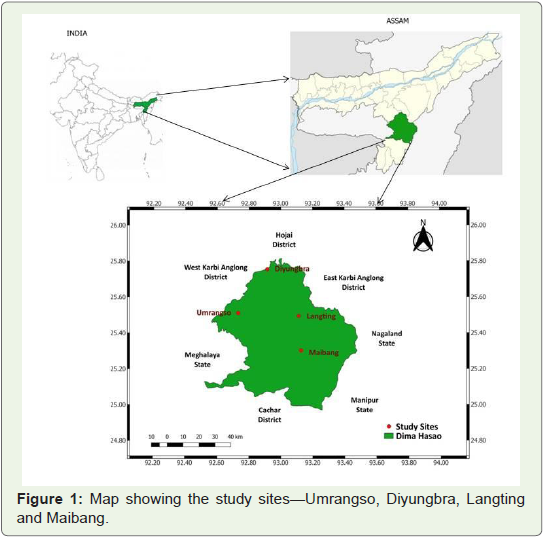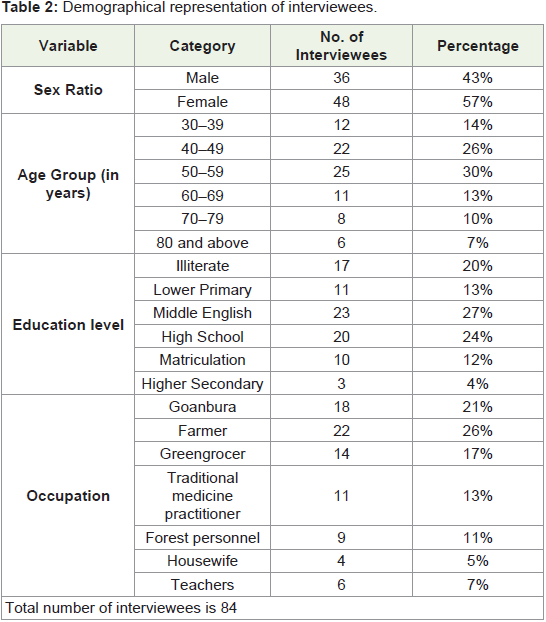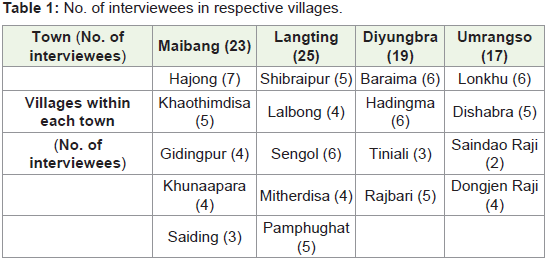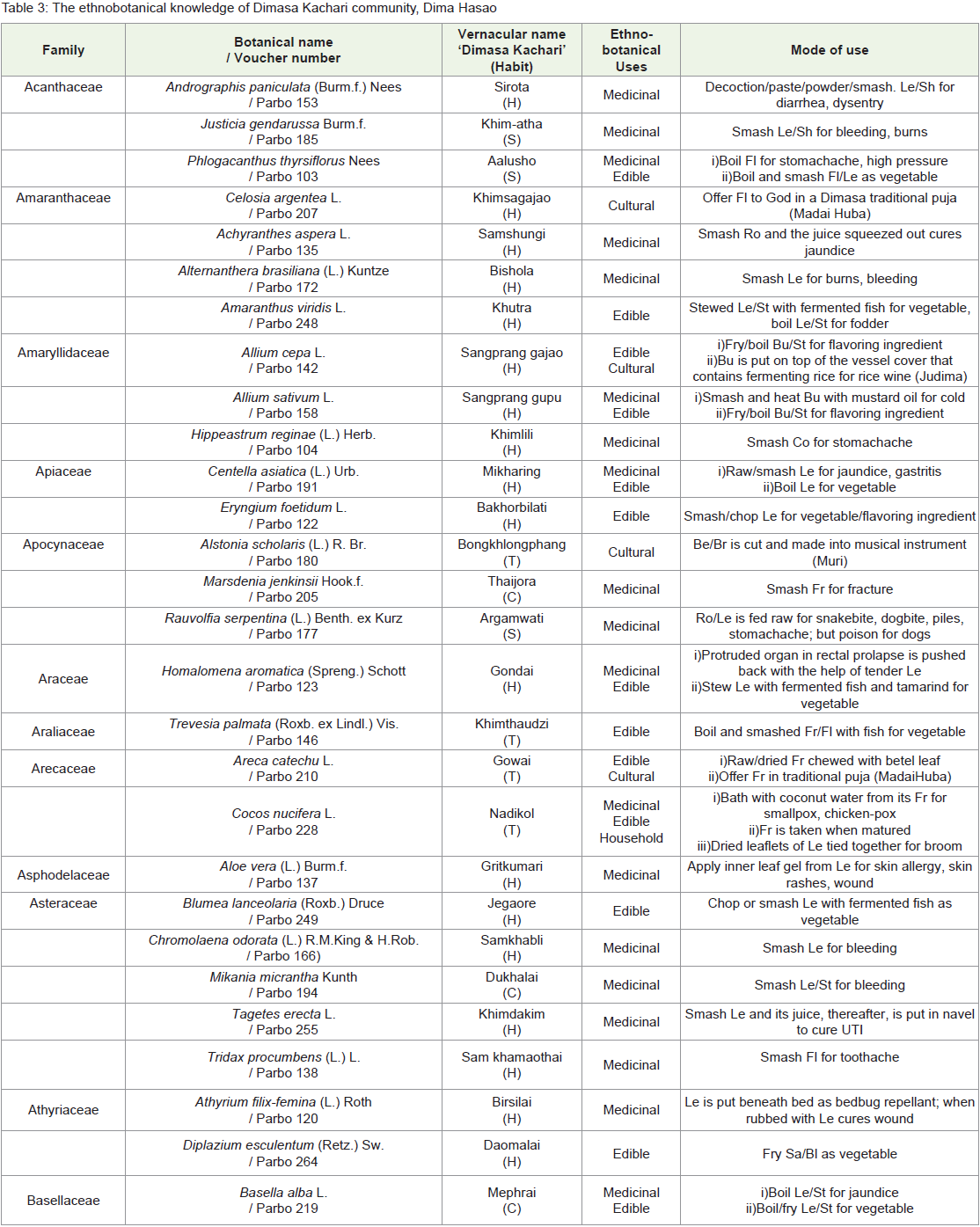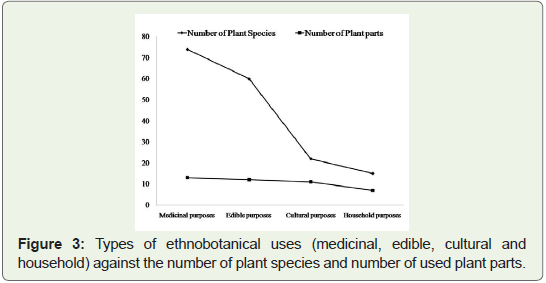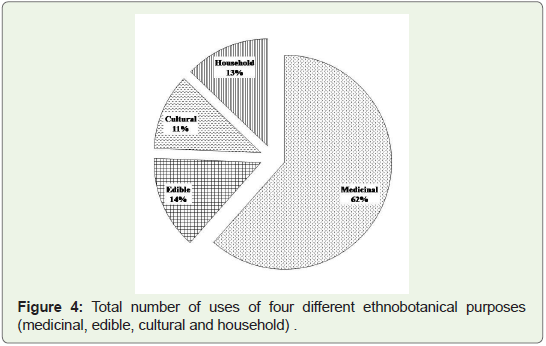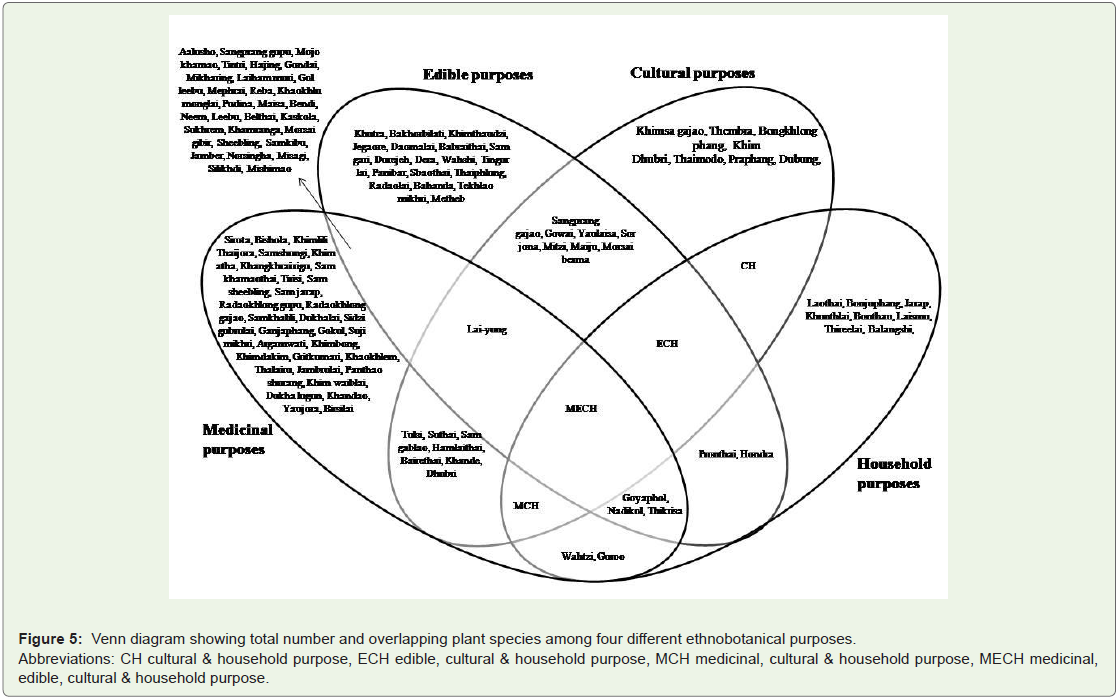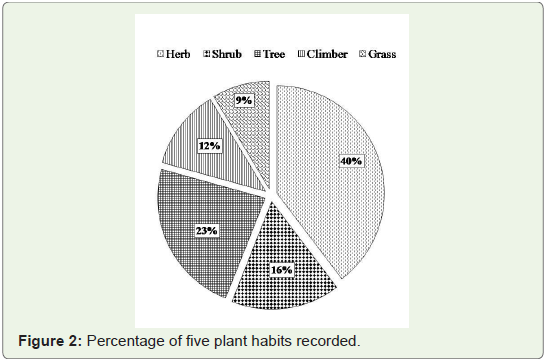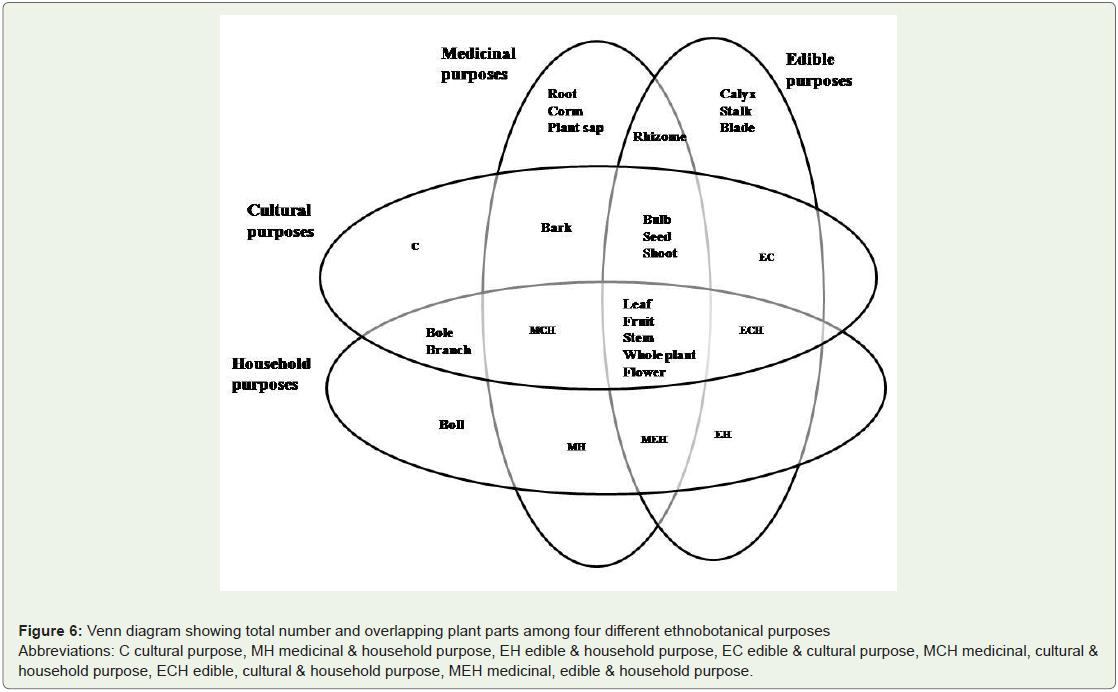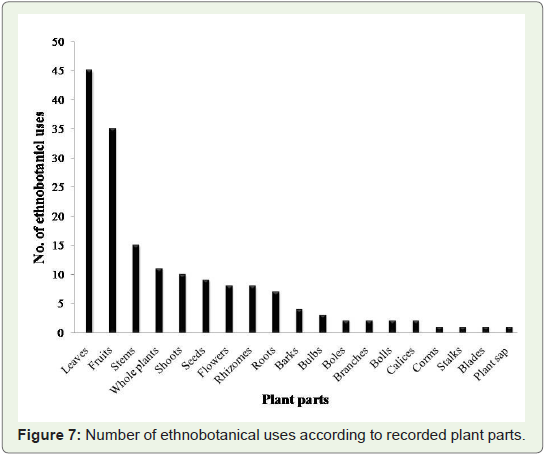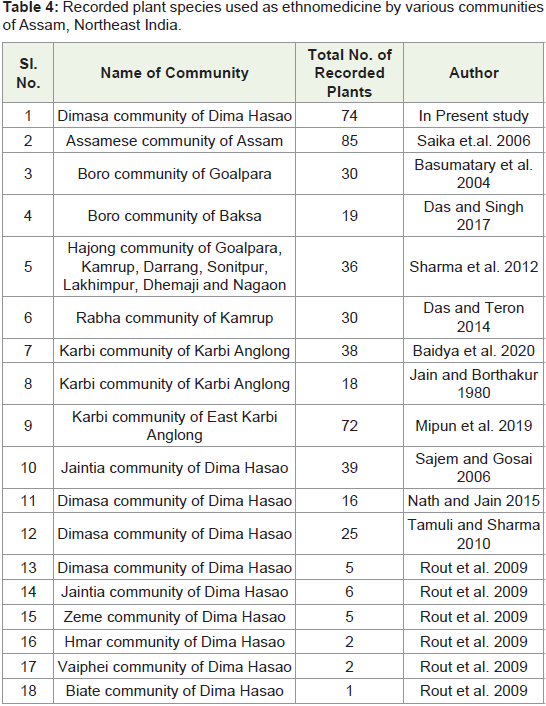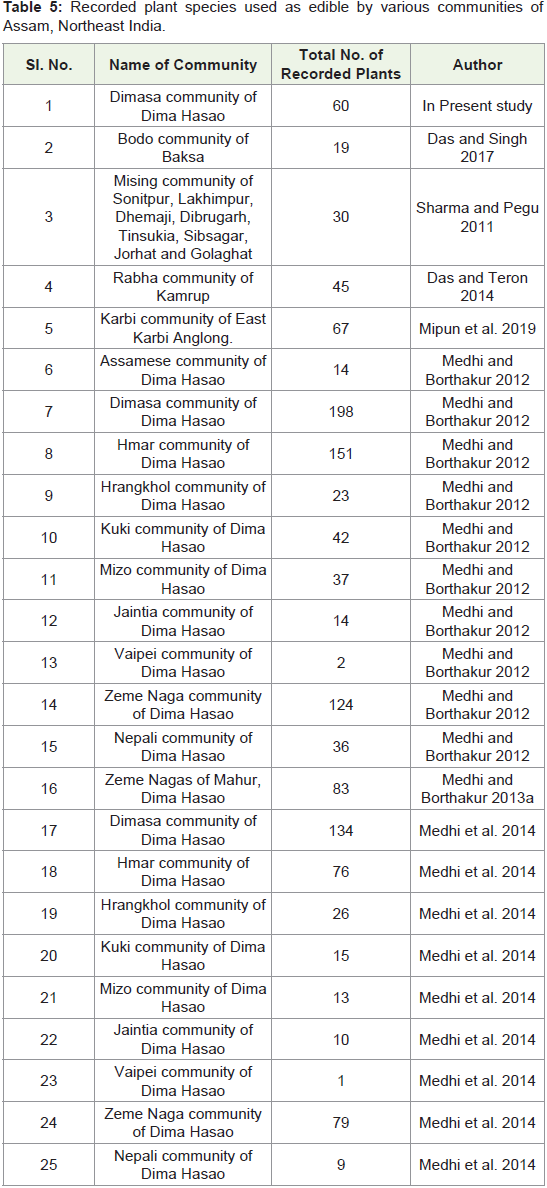Research Article
Ethnobotany: The Ethnicity of the Dimasa Kachari, Dima Hasao, Assam, India
Dipika Parbo* and Awadhesh Kumar
Department of Forestry, North Eastern Regional Institute of Science and Technology, India
*Corresponding author: Dipika P, Department of Forestry, North Eastern Regional Institute of Science and
Technology, Nirjuli, Arunachal Pradesh, India – 791109; Email:deepigir15@gmail.com / tpileatus@gmail.com
Copyright: © Dipika P, et al. 2021. This is an open access article distributed under the Creative Commons Attribution License,
which permits unrestricted use, distribution, and reproduction in any medium, provided the original work is properly cited.
Article Information: Submission: 02/03/2021; Accepted: 08/06/2021; Published: 16/06/2021
Abstract
The Dimasa Kacharis of Dima Hasao, Assam, India have adopted many ethnic ways of using plants, surrounding them, sometimes due to easy
availability or poor communication system. But, with modernization, the ethnicity is gradually fading. Thus, it is very important to scientifically document,
restore and preserve the knowledge of ethnobotany for greater interest of human society. The extensive interview survey has been carried out among the
people of Dimasa Kachari community of 18 villages in Maibang, Langting, Diyungbra and Umrangso of Dima Hasao, Assam from the month of August 2015
to May 2017 following the open-ended questionnaire survey. Sixty-two respondents report a total of 116 plant species and 19 plant parts, of which 74, 60,
22 and 15 species and 13, 12, 11 and 7 plant parts are used for medicinal, edible, cultural and household uses respectively, where some of them are used
commonly. These species are of five plant habits—herbs (46 spp.), trees (27 spp.), shrubs (19 spp.), climber (14 spp.) and grasses (10 spp.). A total of 48
ailments (medicinal uses), 11 edible uses, nine cultural uses and ten household uses are recorded. The study reveals a high diversity of ethnically important
plants in the ethnic life of Dimasas of Dima Hasao.
Keywords
Indigenous; Plants; Ethnic knowledge; Ethnomedicine; Culture
Introduction
Ethnobotany is a study of the relationship between indigenous or
primitive communities of a region and the surrounding environment
particularly the plant world [1,2]. In broader sense, Ethnobotany is
the study of the biological knowledge, of particular ethnic groups,
including medicinal and cultural knowledge about plants and their
interrelationships [3]. The ethnic-indigenous communities dwelling
in and around many forested areas (especially forest fringe areas)
depend on the forest resources for maintaining their livelihoods [4],
such ethnic uses are based from medicinal to cultural purposes, from
aesthetic to economic purposes, from food to clothing purposes.
The ethnic healthcare system is closely related to the culture of the
people and their knowledge of the nature around them [5]. Worldwide,
about 80% of the population depends on traditional health care system
for their primary healthcare system [6], out of which the population in developing countries is found more in using traditional medicines
(60–90%) than that in developed countries (23–80%) [7-9]. Around
60% of commercially available drugs are extracted traditionally by
various indigenous cultures from various natural resources around
the globe [10]. Out of the total 4,22,000 known angiosperms, more
than 50,000 are used for medicinal purposes [11]. Some authors like
Prescott and Prescott (1990:365–
374) and Rapaport and Drausal
(2001:375–382) estimated that there are around 27,000 plant species
of possible food resources in the planet and 103 plant species used
as resources for 90% of the world food supply. Besides, many plants
are widely used in different worships, some are considered sacred
while many others as taboo and symbol of evil, likely based on tale
and folklore [12-15].
India comprises of 427 tribal groups out of which more than 130
major tribal groups are present in North-East India [16]. The district
Dima Hasao comprises of many beautiful ethnic communities, Dimasa Kachari, Zeme Naga, Hmar, Kuki, Biate, Hrangkhol, Khelma,
Jaintia, Vaiphei, Rongmei, Lushai and Karbi, who live harmoniously
together with several other groups like the Assamese, Bengalis,
Nepalis, etc. who are mostly government employees, traders, living in
urban and semi-urban areas [17]. Out of total population of 2,13,529
and population density of 44 individuals per square kilometres, which
is the lowest in Assam, the total population of Dimasa Kachari is
64,881, constituting 32.90% of total population of Dima Hasao. The
term ‘Dimasa’ comprises of three Dimasa words (‘DI’ meaning ‘water’,
‘MA’ meaning ‘great’ and ‘SA’ meaning ‘son’), thus literally ‘Dimasa’
means ‘the son of a Great River’ or ‘the son of the Brahmaputra’
(since the Brahmaputra is the largest and the longest river in Assam;
the Dimasas consider themselves to be the descendants of the river
Brahmaputra). The Dimasa Kachari, linguistically, belongs to the
Tibeto–Burman group and have a prominent Mongoloid features
belonging to Indo–Mongoloid (Kirata Family) [18-22].
The ethnic tribes (Dimasa Kachari as one such) of the district are
gifted with the knowledge of ethnobotanical use of flora including
ethnomedicine and other uses as staple food, household materials,
vegetables, traditional purposes, spiritual beliefs, etc. [23]. The
ailments are cured or being tried to be cured using the plant parts
(root, leaves, stem, bark and so on) by the tribal or indigenous people
from the ancient time till today and such practices are passed through
oral communication from generation to generation without any
proper documentation [24-26].
Although in today’s world of modernisation the Dimasas happen
to cure themselves with modern medicine and get themselves
adapted to modernisation, still there are many areas of the district
where the local people depend on the ethnic ways of living. Since
most of the villages are situated far from mainland of the district and
are inaccessible to transport system due to poor road connectivity,
the villagers find it more convenient to practice traditional ethnic
remedies, food and culture within their localities. Even though, few
healthcare centres and shopping centres are present in some areas
of the district, they lack good and hygiene medicinal facilities. Thus,
ethnic lifestyles are practiced in such areas due to easy availability and
cultural acceptability of the resources and poor economic conditions
[24].
Although in Assam many related works are studied among the
Assamese Community [27], Karbi community [28-30], Mising
community [31], Bodo community [32,33], Rabha community [34],
Hajong community [35] and within Dima Hasao district, Jaintia
community [36-38], Zeme Naga community [36,37,39], Hmar
community [37], Vaiphei community [37], Biate community [37]
and Dimasa Kachari community [21,22,36,37,40,41]. For the better
understanding in the field of ethnobotany, the present study was
conducted, which not only provide them with ethnomedicines but
also act as an important resource for various daily household and
cultural needs.
Methodology
Study Area:
The present study was carried out at Maibang, Langting,
Diyungbra and Umrangso of Dima Hasao district of Assam (Figure 1). Dima Hasao, earlier known as North Cachar Hills, is one of the only
two hill districts of Assam, other being Karbi Anglong. Situated north
to the Barak Valley and with Barail Range as its main range, the major
portion of the district is covered by hills and lesser regions with plains.
Being a part of the Indo-Burma, one of the 36 hotspots of the world
and one of the four hotspots of India, Dima Hasao is garlanded by
alluring hills with its headquarter, Haflong—“Switzerland of the East”
and “Second Shillong”. The highest mountain peak of Assam, Mount
Thumjang, is situated in the district [42]. Situated at the southern
part of Assam between 92°37′–93°17′ E longitude and 25°3′–25°47′ N
latitudes with an altitude of 600–900 meters asl (eastern) and 1000–
1866 meters asl (northern) and covering an area of 4890 sq. km and
temperature range of 10o C to 14o C (minimum) and 24o C to 30o C
(maximum), Dima Hasao is bounded by Nagaland and Manipur
states in the east, Cachar district of Assam in the south, Meghalaya
state and West Karbi Anglong district in the west and Hojai and East
Karbi Anglong districts in the north. The main rivers of the district
are Kapili, Diyung, Dehangi, Jatinga, Jenam, Mahur and Langting,
all originating from the Borail Range [43]. Maibang (Dimasa words,
MAI—rice grain and BANG—plenty), situated at the bank of river
Mahur, is a sub-division of the Dima Hasao. Langting(Karbi word,
LANGTING—Clear Water or Clear River, thus, “Langting” means
“the clear river flow”), also known as Langting Hasin, is a small town
located at the bank of the river Langting. Diyungbra (Dimasa words,
DI—water and YUNG—large) is a small town situated at the bank of
the river Diyung, which mark boundary between Dima Hasao and
West Karbi Anglong. Umrangso (Pnar words, UMRANGSO—red
water or red river) is a small and the only industrial town of Dima
Hasao situated at the bank of the river Kapili.Methods
Sampling Method:
The extensive study had been carried out through field observations and interrogation with the local people following purposive sampling
method [44]. The interviewees were selected based on their ethnicity
and availability of the ethnobotanically important plants. The selected
interviewees include Goanburas (Village Head), traditional medicine
practitioner, forest personnel, farmers, green-grocers and other local
inhabitants (Table 2). For the purpose of excellent learning in-depth
information, the interviewees having age more than 30 years were
preferred [45].Data Collection and Species Identification:
Open–ended questionnaire surveys were used to collect
information about the ethnobotanical uses among the Dimasa
Kacharis of the selected study areas [44]. Each of the four study sites
were visited four times a year from August, 2015 to May, 2017 and
required data were collected during all four seasons from 18 ethnic
villages situated within four towns, Maibang, Langting, Diyungbra
and Umrangso, five villages from Maibang and Langting each, four
villages from Diyungbra and Umrangso each (Table 1). Gaonbura of each and every village was visited firstly, with whose permission and
help the appropriate interviewees were questioned. In addition, the
green–grocers were interviewed in the local markets. The interviews
were done in local language and the species names were recorded in
local names (Dimasa Kachari). Ethnobotanical knowledge, including
local names of ethnobotanically important plants, their present
availability, various uses, useful plant parts and preparation process,
along with the information of interviewees were recorded in note
books and data revealed were transcribed for analysis.Herbaria of collected plant species were prepared and submitted
in the Department of Forestry, North Eastern Regional Institute of
Science and Technology, Arunachal Pradesh. Identifications were
done with the help of experts either from the prepared herbaria or the
photographs captured during field observation.
Data Analysis:
Following the collection and identification, tabulation of the
scientific name, English name, vernacular name, family and habits
of plant species; plant parts used and procedure of preparation for
ethnobotanical uses (medicinal, edible, cultural and household)
and voucher number of the vouchered specimen, along with the
interviewees’ information and the study areas were done. Comparison
of four ethnobotanical uses based on number of plant species and
used plant parts and based on overlapping plant species and used
plant parts was prepared.Results
Interviewees Information:
A total of 84 interviewees participated; firstly the Gaonburas
(Village Head) and the elderly persons were interviewed followed
by traditional medicine practitioners, green-grocers, farmers, forest
personnel, housewives and school teachers; the highest number of
interviewees were farmers (26%), whereas, housewives were the
lowest (5%) (Table 2). Out of the total four towns, the highest number
of interviewees was documented from Langting (30%), followed by
Maibang (27%), Diyungbra (23%) and lowest from Umrangso (20%).
These towns comprise of 18 small villages and the highest number of
interviewees was documented from Hajong (8%) and the lowest from
Saindao Raji (2%) (Table 1). The female interviewees were higher in
number (57%) than the males (43%). Considering the age group of
the interviewees, the highest number of interviewees recorded was
between 50–59 years of age and the lowest, between 80–89 years. In
addition, majority of the interviewees were farmers and had mostly
academically qualified their middle standard in terms of education
(Table 2).Etnobotanical Uses:
Diversity of Plant Species: A total of 116 plant species, belonging
to 48 families and 101 genera, are documented from 18 different
ethnic villages of four towns—Langting, Maibang, Diyungbra and
Umrangso of Dima Hasao district of Assam (Table 3). Among
48 families, highest number of species is recorded from Poaceae
i.e eight species, followed by Fabaceae (9 spp.), Rutaceae (7 spp.),
Malvaceae (6 spp.), Asteraceae, Lamiaceae, Moraceae and Solanaceae
(5 spp. each), Amaranthaceae (4 spp.), Acanthaceae, Amaryllidaceae, Apocynaceae, Cucurbitaceae, Euphorbiaceae and Zingiberaceae (3
spp. each), Apiaceae, Arecaceae, Athyriaceae, Meliaceae, Musaceae,
Oxalidaceae, Phyllanthaceae, Urticaceae and Vitaceae (2 spp. each)
and Araceae, Araliaceae, Asphodelaceae, Basellaceae, Brassicaceae,
Bromeliaceae, Cannabaceae, Caricaceae, Cannaceae, Combretaceae,
Convolvulaceae, Crassulaceae, Moringaceae, Myrtaceae,
Nymphaeaceae, Pedaliaceae, Pinaceae, Piperaceae, Portulaceae,
Rubiaceae, Saururaceae, Scrophulariaceae, Smilacaceae and
Verbenaceae (1 sp. each). Out of recorded 101 genera, Citrus has the
highest number of species of five, Solanum, Capsicum, Saccharum,
Oryza, Musa, Ficus, Sida, Ocimum, Acacia, Jatropha and Allium have
two number of species each and the remaining 89 genera have one
species each.The four ethnobotanical uses, viz. medicinal, edible, cultural and
household, are studied from 116 collected plant species. Out of 116
species, 74 species (64%) are used for medicinal purpose, 60 species
(52%) for edible, 22 species (19%) for cultural and 15 species (13%) for
household purposes (Figure 3). Many of the plant species are found
commonly used for all the four ethnobotanical uses, for example,
Musa balbisiana, Phlogacanthus thyrsiflorus, Citrus sinensis, Oxalis
corniculata, Melocanna baccifera, Piper betle, Mimosa pudica, Basella
alba, Psidium guajava, Houttuynia cordata, etc. It is found that the
total number of ethnobotanical uses is 78—48 types of ailments (62%,
medicinal uses), 11 types of edible uses (14%), nine types of cultural
uses (11%) and ten types of household uses (13%) (Figure 4, Table 3
).
The relation between the four ethnobotanical uses (medical, edible,
cultural and household) and the plant species on the basis of the total
number of documented plant species and overlapping plant species
used is shown in Figure 5. Out of 116 species, 32 species for medicinal
purpose (27%), 18 species for edible purpose (15%), seven species for
cultural purpose (6%) and eight species for household purpose (7%)
are exclusively used. The common species used for medicinal and
edible purpose are 29 (25%), for medicinal and cultural purpose are
seven (6%), for medicinal and household purpose are two (2%), for
edible and household purpose are two (2%), for edible and cultural
purpose are seven (6%), for medicinal, edible and cultural purpose is
only one (1%), for medicinal, edible and household purpose are three
(3%). There are no common species used for cultural and household
purpose (CH), for medicinal, cultural and household purpose
(MCH), for edible, cultural and household purpose (ECH) and for all
four ethnobotanical uses (MECH) (Figure 5).
Figure 3: Types of ethnobotanical uses (medicinal, edible, cultural and
household) against the number of plant species and number of used plant parts.
Figure 4: Total number of uses of four different ethnobotanical purposes
(medicinal, edible, cultural and household).
Figure 5: Venn diagram showing total number and overlapping plant species among four different ethnobotanical purposes.
Abbreviations: CH cultural & household purpose, ECH edible, cultural & household purpose, MCH medicinal, cultural & household purpose, MECH medicinal,
edible, cultural & household purpose.
Habits of Plant Species: Five different habits of documented plant species are observed—herb, shrub, tree, climber and grass.
There are 46 species of herbs (40%), 19 species of shrubs (16%), 27
species of trees (23%), 14 species of climber (12%) and ten species of
grass (9%) (Figure 2). The highest number of plant species is recorded
to be herbs followed by trees, shrubs, climbers and by grass. Among
101 recorded genera, 42 genera of herbs (41%), 15 genera of shrubs
(15%), 22 genera of trees (22%), 14 genera of climber (14%) and eight
genera of grass (8%). None of the genera is recorded to have more
than one plant habit, each and every genus comprise of only one
plant habit—all the five plant species in genus Citrus are trees, two
species of Sida genus are shrubs and so on (Table 3). Out of total 48
families, herbs are documented from 27 families (56%), shrubs from
nine families (19%), trees from 15 families (31%), climber from 11
families (23%) and grass from one family, Poaceae (9%). It is recorded
that a family may consist of more than one plant habit—Apocynaceae is recorded with tree, shrub and climber, or may consist of only one
habit—Basellaceae is recorded only with climber and Poaceae is
recorded only with grass (Table 3).
Plant Parts:
For various ethnobotanical purposes, a total of 19 plant parts
are documented to be used, such as leaf, fruit, stem, whole plant,
shoot, seed, flower, rhizome, root, bark, bulb, bole, branch, bolls,
calyx, corm, stalk, blade and plant sap. Out of total 78 ethnobotanical
uses, including medicinal, edible, cultural and household purposes,
45 number of uses are done from leaves, 35 uses from fruits, 15 uses from stems, 11 uses from whole plants, ten uses from shoots, nine uses
from seeds, eight uses each from flowers and rhizomes, seven uses
from roots, four uses from barks, three uses from bulbs, two uses each
from boles, branches, bolls and calices, and one use each from corms,
stalks, blades and plant sap (Figure 7). Out of 19 used plant parts,
13 parts (68%) are used for medicinal purpose, 12 parts (63%) for
edible purpose, 11 parts (58%) for cultural purpose and seven parts (37%) for household purpose (Figure 3). Most of the recorded plant
parts are used commonly among four ethnobotanical purposes—leaf,
flower, stem, fruit, whole plant are used in all four ethnobotanical
purposes, shoot, bulb and seed are used in medicinal, edible and
cultural purposes, bole and branch for cultural and household
purposes, rhizome for medicinal and edible purposes, bark for
medicinal and cultural purposes; while fewer plant parts are used only
for one purpose—root, corm and plant sap for medicine, stalk, blade
and calyx as edible, boll for household purpose (Figure 6).
Figure 6: Venn diagram showing total number and overlapping plant parts among four different ethnobotanical purposes
Abbreviations: C cultural purpose, MH medicinal & household purpose, EH edible & household purpose, EC edible & cultural purpose, MCH medicinal, cultural &
household purpose, ECH edible, cultural & household purpose, MEH medicinal, edible & household purpose.
The relation between the four ethnobotanical uses and the used
plant parts on the basis of the total number and overlapping plant parts
used is illustrated in Figure 6. Out of total 19 plant parts, three plant
parts as medicine, three parts as edible and one part for household
are used. One part for medicine and edible, one part for medicine
and cultural, two parts for cultural and household, three parts for
medicine, edible and cultural, and five parts for medicinal, edible,
cultural and household are commonly used. But no part is recorded
used for cultural only (C), commonly for medicine and household
(MH), for edible and household (EH), for edible and cultural (EC),
for medicinal, cultural and household (MCH), for edible, cultural and
household (ECH), and for medicinal, edible and household (MEH)
(Figure 6). Among various uses of total 19 plant parts, leaf is found
to be used in highest number (i.e. 45 uses) and corm, stalk, blade and
plant sap are used in least number (i.e. for one use) ethnobotanically
(Figure 7).
Process of Preparation
Many processes of medicine preparations are carried out
traditionally. Smashing of leaf, shoot, root, bulb, corm, rhizome, fruit,
flower, bark or whole plant is most followed process to cure ailments
like diarrhea, bleeding, burns, jaundice, wound, cold, immunity,
fracture, UTI, stomachache, gastritis, boil, diabetes, cough, toothache,
skin allergy, skin rashes, chickenpox, smallpox, malaria, dysentery,
muscle pain and joint pain. Boiling is another process where few
plant parts like flower, rhizome, leaf, stem, fruit, whole plant or
shoot are boiled and consume to treat stomachache, high pressure,
jaundice, gastritis, gas, cold, piles, lactation, skin allergy, skin rashes,
wound, chickenpox, smallpox, hemoglobin level, dysentery, rectal
prolapse, diabetes, low pressure, childbirth and immunity. Some
plant parts like fruit, leaf and root are taken raw to cure diseases like
digestion, calculus, gastritis, hypertension, parasitic worm, rectal
prolapse, jaundice, snakebite, dog-bite, dysentery, diarrhea, piles,
gas, stomachache, low pressure, diabetes and hemoglobin level. For
the treatment of few diseases, headache, diabetes, gas, hemoglobin
level, balanitis, lactation and menorrhagia, plant parts like leaf,
fruit, flower, stem and rhizome are fried and taken in meal. Taking
bath with coconut water may cure chickenpox and smallpox. Few
skin problems, skin allergy, skin rashes and wounds can be treated
by applying gel from the leaves. Placing of leaves of certain species
beneath the bed may keep the bedbug away. Many other processes like
applying plant sap, tying the root for navel displacement, squeezing
out the juice from leaf, stem or fruit, fermenting Citrus aurantiifolia
for stomachache were also documented (Table 3).
In case of edible purpose, many of the plant species are taken
as vegetables, fruits, flavoring ingredients, coloring ingredients and chewable. Stems, leaves, fruits, seeds, flowers, shoots and whole
plants are stewed or simply boiled either with or without fermented
fish (naphlam) and served as vegetables. Even raw leaves, seeds and
flowers are either smashed or chopped and are prepared as chutneys.
In some cases, stalks, blade, bulb, stem, leaves and flowers are fried
and fed. To feed as fodder for eri silkworm, tender Ricinus communis
leaves are plugged and served, while for pig leaves and stems are
boiled. Raw or dried fruit of Areca catechu is chewed with betel
leaf. Seeds are smoked, powdered or taken directly as vegetable or
flavoring ingredient. Seeds of Abelmoschus esculentus and Hibiscus
sabdariffa as ‘enzang’ and bamboo shoot (miya) of Bambusa tulda
as ‘miyamikhri’ are fermented and stored. Rice (maisa) is steamed
and taken as staple food, while glutinous rice (maiju) is steamed and
served in the festival (Bushu Dima) as a special dish. Lastly, matured
fruits of Terminalia bellirica are taken as wild nuts and ripe fruits of
Lantana camara and Bridelia stipularis as wild fruits (Table 3).
The Dimasa Kacharis conduct many traditional pujas (Madai
Huba) or religious Hindu pujas where offerings of flowers, fruits,
leaves and shoots of various plants to Deities are made; they
even sprinkle mustard seeds or tie in a cloth in a traditional spell
(Phrenba); sometimes they conduct puja with a tree species as their
Deity, for they belief either the plant is a Numen or few plants to be a
Numen (Ficus religiosa) for the protection of the child (e.g. Streblus
asper, Phyllanthus emblica); some believe Parkia speciosa to be
sacrilegious, powdered seeds of Entada rheedii and leaves of Ocimum
tenuiflorum are considered for purification and sacred. Besides, the
Dimasas believe rooting of Portulaca grandiflora inside a house to be
a bad omen for the members of the house. Two traditional musical
instruments—‘
kharam dubung’, prepared from the dried stems
of Saccharum spontaneum and ‘Muri’, prepared from the bole and
branches of Alstonia scholaris. Judima (rice wine) has a vital role
in Dimasa culture in the preparation of which the bark of Albizia
myriophylla is dried, powdered and mixed with rice powder, which
is then made into biscuits and sundried. The cooked rice is spread in
a clean mat and is allowed to cool; once cooled, a part of the biscuit
is mixed with, which is then stored in a closed container allowing
to ferment. The onion and chilli are kept on top of the contatiner
cover. Known to very less, some part of Dimasas even prepare banana
wine where banana fruit are simply chopped or smashed and kept in
a closed container and allowed to ferment. Few traditional clothes of
Dimasas are made in handloom, while traditional cloth, ‘rihthap’, is
made of erisilk, when fruits of Melia azedarach are boiled and its thick
stock is used in brushing the thread in the loom (Table 3).
Various household materials like broom, detergent, vessel, cooker,
scrubber, pillow, mattress, igniter (or kindler), thatched roof, fence,
firewood, facemask and cooking materials are prepared from various
plant parts of different species. Leaflets of Cocos nucifera, stems of
Sida acuta and flowers and stems of Thysanolaena latifolia are dried
and tied up together in a bunch and used as broom. Raw fruits of
Carica papaya and whole plants of Oxalis corniculata have cleansing
properties (as detergent) which are used to clean utensils, especially
the brass utensils. Fruits of Lagenaria siceraria are dried and emptied
by removing their seeds and used as kettles for serving judima (rice
wine); a Melocanna baccifera, when cut in its internode keeping one
side open and the other closed, used as vessel or cooker for vegetables, rice, tea or water; leaves of Solanum erianthum are used as cooking
materials—when glutinous rice is steamed in two utensils (one above
the other), the leaves are placed between the gaps of the two utensils
to block air passage, thus vaporization helps rice to cook faster. Dried
Luffa cylindrica is used as scrubber, a toilet material, by removing
its seeds and cover. Even pillows and mattress are stitched with the
seed hair-fibres of Gossypium arboreum and Bombax ceiba. Leaves
of Imperata cylindrica are tied in a bunch and used to make roof of a
hut. The bole and branches of Pinus kesiya are cut into smaller pieces
and used as igniter (or kindler). Even peels of Citrus sinensis and leftovers
of Saccharum officinarum after squeezing out its juice, are used
as facemask and firewood respectively (Table 3).
Discussion
The present study has brought into light the list of 116 plant
species that are ethnobotanically important for the Dimasa-Kachari
community of Dima Hasao, Assam. Most of the ethnobotany subject
was studied based on medical values, followed by edible, cultural,
religious and cosmetics [27,31,34,36-38,46-49]. In present study,
the ethnobotany is mainly categorized into four different purposes medicinal,
edible, cultural and household.
Many works were carried out to limelight the importance of plant
species used as ethnomedicine by various communities of Assam
(Table 4). Saikia et al. (2006) has reported the highest number of plant
species (85 species) used as ethonomedicine by Assamese community,
little higher than recorded in the present study (74 species) (Figure 3,
Table 3, Table 4). While Mipun et al. (2019) has recorded 72 species
among the Karbis, almost similar to the present study. The rest of
studies listed in Table 4 have reported lower number of plant species
as ethnomedicine with the lowest of one plant species used by Biate
community of Assam. Considering the various studies done in Assam,
Medhi and Borthakur (2012) have recorded higher number of plant
species (198 species) consumed by Dimasas of Dima Hasao as edible
in compare to present study which documented only 60 edible species
among the Dimasas (Figure 3, Table 3, Table 5). However, similar
finding to the present study is 67 species as edible forest products of the Karbis [30]. In this study we reported total of 22 plant species
used for a range of cultural purposes (Figure 3, Table 3). Sharma et
al. (2012) had documented higher number of species (36 plants) used
by the Hajong community, along with Medhi and Borthakur (2013b)
findings of 34 species among the Dimasas. A few plant species, 5
species and 37 species were recorded by Das and Teron (2014) and
Jain and Borthakur (1980) among the Rabha and Karbi community
respectively. In Assam, various plants have various household
purposes—Haflongbar and De (2017) studied the traditional way of
classification of 161 plant species among the Dimasas; Das and Teron
(2014) recorded 41 species among Rabha community and Mipun et
al. (2019) recorded 32 species among Karbis, where the plant number
are higher than the documented in the present study: 15 plant species
are recorded for various household uses (Figure 3, Table 3). Jain and
Borthakur (1980) had reported very few species (four species) for
recreation used by the Karbis.
Table 4: Recorded plant species used as ethnomedicine by various communities
of Assam, Northeast India.
Out of 116 documented plants, few plant species are used
commonly among the four purposes (Figure 5). Most plants are
found useful for treating many ailments with highest number
(eight) for the treatment of dysentery and lowest (one) is used
in immunity, menorrhagia, muscle pain, joint pain, cough, eye
infection, digestion, insect repellant, excess urination, low pressure,
balanitis, parasitic worms, bedbug repellant, earache, malaria,
childbirth, navel displacement, snake bite, dog bite, lactation and
white discharge. Besides treating human beings, few plant species are
also used as ethnomedicines for domesticated animals—raw leaves of
Bryophyllum pinnatum are fed to cattle to cure its upset stomach and
plant sap of Leucas aspera cures an eye infection of goat. There are few
plants that are adverse for both human and animal—consumption of
Clerodendrum glandulosum leaves worsen the condition of low blood
pressure patients, whereas consumption of the same is beneficial
for high blood pressure patients; Rauvolfia serpentina is poisonous
for dogs. Among the four different ethnobotanical uses, it is to note
that from the recorded plant species, the ethnic culture of Dimasas is
popular for the use of ethnomedicine (48 ailments), followed by edible
purpose (11 uses), then household (ten uses) and then by cultural
uses (nine uses) (Figure 4). Out of many crops grown, rice is mostly
cultivated followed by maize, sesame, mustard, melons, pumpkin,
ginger, turmeric, etc. Oryza sativa has a varietal nomenclature whose
generic term is ‘mai’ and varietal taxa are ‘maisa’ and ‘maiju’ [40,50].
The harvest festival, ‘Bushu Dima’, of the Dimasa Kachari community
is celebrated annually in the month of January.
Although almost all the local inhabitants acquire the
ethnobotanical knowledge, but it is mostly recorded from the people
with 30 years of age or more, as they are more experienced and possess
traditional knowledge, skill and wisdom. Most of the interviewees’
age ranged from 30–59 years and very few between 60–89 years. This
shows that ethnic knowledge is acquired from 30 years and increase
as they grow older. Again the number of interviewees is noted to
decrease after 60 years and became least between 80 and above years,
it must be likely due to increased death rate from 60–89 years. Most
of the interviewees are farmers, thus closely related to wild flora and
have better-off ethnobotanical knowledge (Table 2).
One of the factors responsible for the increase in ethnobotanical practice among the Dimasas is that they live remotely from the
mainland of the state. Medhi and Borthakur (2012) mentioned
that the communication system in the district of Dima Hasao is of
‘bottleneck communication’ with the inhabitants preferring to live
undisturbed and far away from the ‘market economy’. There are very
few medical centers in the villages or sometimes not having any. Since
civil hospitals and other medical facilities are found in the mainland,
people face difficulties to access such facilities, allowing them to
practice and follow the uses of some home-made and herbal remedies
to cure ailments. Although with the upcoming of modern facilities,
due to the availability of ethnomedicinal resources and ancestors’
knowledge, the ethnic way of treatment is found to be encouraged
among the inhabitants and are found to be effective in curing many
diseases. Besides this, the Dimasas depends on natural resources for
their various daily purposes like edible, cultural and household needs,
for their ethnicity encourage them to acquire their daily needs from
their surrounding (huge diversity and abundance of floral species)
due to the easy availability of the resources since times immemorial.
In case of edible purposes, most of the wild plants are consumed as
organic vegetables and thus preferred more. A certain sect of Dimasa
Kacharis regard Entada rheedii and Ocimum sanctum as sacred,
Phyllanthus emblica, Ficus religiosa and Streblus asper as ‘Numen’
and hence these are being worshipped; while some other Dimasas do
not have such beliefs.
It has been observed that in course of time, the idea of ethnobotany
is dwindling. It might have been due to the fact that modern
medicine facilities become easily available to some accessible areas
in course of time. Some also believe that the dwindling of the ethnic
knowledge may be due to decrease in the availability of species and
sometimes extinction. Such an example is of ‘Mojongphong’ (local
name in Dimasa), which was a herb species consumed as vegetable
but presently, the species and its identification could not be found.
‘Khim-ridi’ and ‘Khim-balao’ (local name in Dimasa), are also such
examples used in death ceremony and hardly available at present.
Albizia myriophylla (themra) is another example, which is used for
the preparation of local liquors, rice wine (judima) and distilled
liquor (juharo), from rice. Albizia myriophylla is found on a rare basis
and hence only the interior villagers are observed selling them very
rarely. The Dimasas, like any other ethnic groups of Dima Hasao,
depends mainly on Jhum or Slash and Burn cultivation or Shifting
cultivation (‘Padaaing Haagong’, in Dimasa) is the major agricultural
practice among the ethnic groups of Dima Hasao, which also plays
a vital role in climate change of the district [37,38]. Moreover, the
ethnomedicinal knowledge among the community is regarded secret
and passed-on only to family members orally from one to next
generation, never to be shared to someone other than the family
members [27]. By such, they maintain to keep the importance and
demand of the particular family among the community and it remain
confined to the family. Thus, this family bound ethnobotanical
knowledge remain unshared and vulnerable, likely to vanish in near
future. The biodiversity of the district is also disturbed to some extent
due to National Highway 54 (E) and Lumding Silchar Broad Gauge
passing throughout the district. Inspite of disturbed biodiversity,
forest of Dima Hasao is enriched with wild flora and fauna. Hajong
Lake, a unique oxbow lake, situated at Hajong village at the outskirt
of Maibang, within Langting–Mupa Reserve Forest, is famous for the
presence of its unique species of Nilssonia formosa, an endangered
species. Few places of Dima Hasao, viz. Jatinga, Doiheng and
Umrangso, are famous for migratory birds (e,g. Falco amurensis),
in favor of which a festival called Falcon Festival is organized every
year at Umrangso any convenient day from the month of August to
November.
Although the ethnicity of the Dimasa Kacharis encourages them
to heal various ailments successfully, it would be much better if the
medicinal properties of the documented plant species be tested.
Thereon, the application of the ethnomedicinally important plants
would be broader, reaching out to larger number of population. Thus,
the ethnobotanical knowledge of the indigenous people of Dima
Hasao should have immediate and proper scientific documentation,
preservation and conservation thereof for their future sustainability
[37,38].
Acknowledgement
The authors are really grateful to all the respondents of Dima
Hasao for giving their valuable time and sharing their ethnobotanical
knowledge during the field survey. A special thanks to Department
of Forestry of North Eastern Regional Institute of Science and
Technology, Arunachal Pradesh, India, where the prepared herbaria
is collected and the experts of the department for helping us with
plant identifications. We are also thankful to our family members for
their support.

